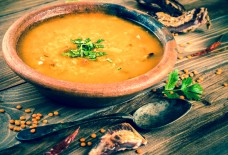Spice Up Your Life with Moroccan Tagine
By: Blanche Shaheen/Arab America Contributing Writer
As the months drag on and I get increasingly impatient with the redundancy of lockdown life, I find myself creating kitchen “staycations” through exciting new meals inspired by countries abroad. I have always fantasized about visiting Morocco in particular, and I felt it was time to bring Morocco to my kitchen, through a traditional tagine stew.
While westerners emphasize the second syllable with the word “tag-INE,” in Arabic the first syllable is emphasized, as in TA’gine. Tagine is Morocco’s signature dish and can be traced as far back as the 9th century in a publication that included recipes called The Thousand and One Nights. Harun al Rashid who ruled the Islamic Empire continued that tradition into the 18th century. It is easy to see why this special dish has transcended several centuries and dynasties. Traditionally the meat is slow-cooked with hearty and satisfying root vegetables in a savory spice blend of paprika, cumin, ginger, cinnamon, coriander, allspice, nutmeg, and cloves. Ras el Hanout is a popular Moroccan spice that is basically an amalgam of all of these spices together. I find that it is an easy one-stop-shop spice blend to season your tagine without all the measuring and guesswork. Dried fruit like plums, apricots, or dates is cooked with the meats to add a mildly sweet and rich flavor and texture. A crowning of crunchy almonds and fresh cilantro often finishes the dish.
While most people associate the word tagine with the actual Moroccan stew, the word also alludes to the beautiful dome shaped clay vessel in which this dish is cooked. The cone shape allows the air to circulate throughout the cooking process, keeping the vegetables and meat moist and flavorful without the need for much liquid.
Today you can find tagines in all sizes–some can serve two, and some can serve up to 10 people. The cooking vessel is traditionally made of clay or ceramic and can be left as is or coated in a glaze. Many cooks and chefs prefer the unglazed clay tagines because they add an earthier flavor to dishes. If using a tagine at home, it is vitally important to use a heat diffuser at the bottom of the pot, to prevent the tagine from cracking from direct heat. You can also make tagine in a traditional pot, or even a slow cooker.
In the video below, you can see how easy it is to add some excitement to your life with a traditional tagine stew made with lamb. You can substitute any kind of meat you wish if you don’t like lamb, or use chickpeas for a vegetarian alternative.
Lamb Tagine
Ingredients:
- 4 carrots
- 4 potatoes
- 3 tbsp olive oil
- 1 small onion, finely chopped
- 1 1/2 pounds of lamb leg, cut in chunks
- 4 tsp Ras El Hanout, divided: https://amzn.to/3cpqxBw
- Salt and pepper to taste
- 1 cup beef broth
- 1/2 cup dried apricots, or dried plums, or a combination of both
- 1/4 cup chopped fresh cilantro
- 2 tbsp blanched almonds
Slice the carrots and potatoes into oblong slices. In a skillet, heat the olive oil, and saute the onions until soft. Add the lamb, 2 tsp. Ras El Hanout, salt and pepper to taste, and saute only until browned, the cooking process will finish in the tagine. Place the lamb in the center of the tagine or pot. In a separate bowl, season the carrots and potatoes with the remaining 2 tsp Ras el Hanout, salt and pepper. Nestle the dried fruit in between the lamb, and place the carrots and potatoes over the lamb like a dome. Add the broth to the vegetables and meat (you might have to use less broth in the tagine, depending on how deep it is) Place the tagine over a heat diffuser, and cook over medium heat, or until the broth starts to boil. Cover and simmer for 1 hour. Garnish with chopped cilantro and almonds before serving. Serve as a stew, or over couscous if desired.
hi
Blanche Shaheen is a journalist, host of the YouTube cooking show called Feast in the Middle East and cookbook author. For more authentic and classical Middle Eastern recipes, you can now purchase her brand new cookbook: “Feast in the Middle East, A Personal Journey of Family and Cuisine” by clicking HERE:https://secure.mybookorders.com/Orderpage/2189
To check out her cooking video tutorials and other recipes follow Blanche on
YouTube: https://www.youtube.com/user/blanchetv
Blog: www.FeastInTheMiddleEast.com
Instagram: @BlancheMedia
Facebook: Blanche’s Feast In the Middle East
Check out Arab America’s blog here!








